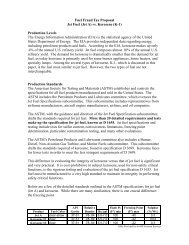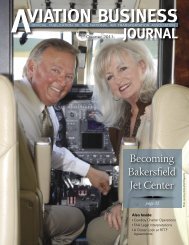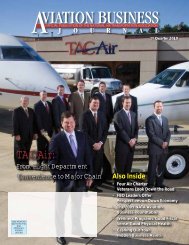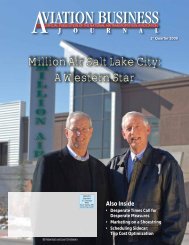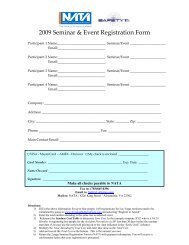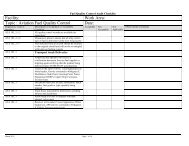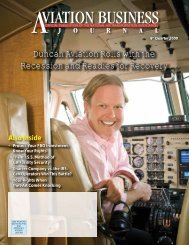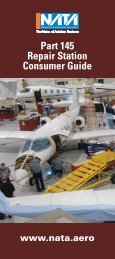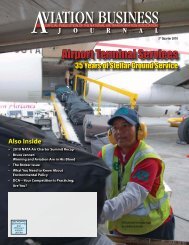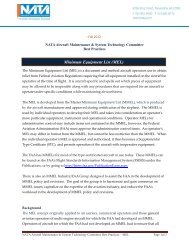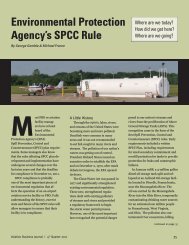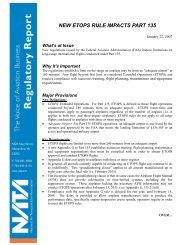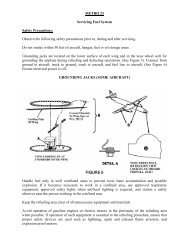Computer-Based Maintenance Tracking Flight Training ... - NATA
Computer-Based Maintenance Tracking Flight Training ... - NATA
Computer-Based Maintenance Tracking Flight Training ... - NATA
- No tags were found...
You also want an ePaper? Increase the reach of your titles
YUMPU automatically turns print PDFs into web optimized ePapers that Google loves.
changes, and it costs you some money. If you do alot of international flying, sometimes it’s slower toget permits if you’re commercial, where procuringpermits for private operations are easier,” he said.The introduction of the “fractional card programs”(essentially block charter purchases) further enhancesthe market, but then need to be operatedentirely under Part 135.“Jet Solutions has a card program, named Flexjet25,” Keith said. “I’ve sold a lot of cards so far. Wejust started about twelve months ago so we’re off toa good start.”Between fractional, charter, and card program flying,the Bombardier-exclusive Flexjet/Jet Solutionsfleet, joined at the hip, aims to fly each aircraftabout 1,000 hours a year.“Both Flexjet and Jet Solutions are regulatedentities that have been able to maximize the waywe work together. Jet Solutions operates all the 135commercial flights and does all the maintenance.Flexjet operates the 91K flights. Most fractionalcompanies dispatch between 30 and 50 percentof their flights under Part 135 because they don’tfit under the legal safe harbor conditions requiredunder Part 91K,” he said.The 2005 accident at Teterboro airport, whichtriggered an invasive nationwide FAA review ofoperational control among 135 certificate holders,hasn’t changed Keith’s operations a lot, he said.“We’ve been very involved with the FAA to makesure that we can comply with their guidance onoperational control issues. But for top level operators,A0008 (an FAA operational control guidance)codifies what they’ve been doing anyway, and itsort of levels the playing field a little bit. Most ofthe top-level operators in the country had made allof the infrastructure investments to be in complianceall the time. Requiring all to do so makes themarket fair from a competitive standpoint. And theNational Transportation Safety Board has clearlymade a case that the relationship between a managementcompany and an air carrier is important inbeing able to deliver a safe product,” he said.Operators not able to come into compliance withoperational control requirements will “go away,”which is fine with Keith.Consolidation on the HorizonA shrinking Part 135 air carrier community alsomay come as the result of consolidation, in Keith’sview.“This business is ripe for consolidation becausethere are benefits of scale, to operating large fleetsefficiently. Over the next five to ten years, we’re goingto see consolidation buyouts in the charter market.I think you’re also going to see some charterproviders merging together. I don’t know if you’llsee other fractional providers merging togetherbecause we are at four large operations, and they’llprobably just continue to grow.“But on the charter side, the world will change alittle bit. You’re seeing it already, but at a differentspeed than FBO mergers because the merger of 135operators is not as easy as buying an FBO and puttinga new sign up. It’s a much more complicatedoperation.“The guys in the top tier in this market are goingto get benefits of scale because they’ve made theinfrastructure investments. The guys in the middleare the ones that are going to be in play becausethey are either going to make the investments andget big enough on their own to make it work or“Charter and fractional productsare going to blend together ina way that offers a variety ofproducts to any customer, alloffered by the same company.”they’re going to be the ones that are going to haveto start consolidating in a way that makes sense.The little local guy, with two or three airplanes, willstill be around. I think the ones that are at risk arethe medium-sized ones in the big city, with five toten airplanes but competing with people who have90 airplanes. The mid-size guys are competing withbigger guys who have cost-effective infrastructures,so they’re going to have a tougher time.”As a result, five years from now, they’ll be fewer135 operators, but “they’ll be bigger ones,” Keithsaid. “I think the marketplace will be bigger, andthere will be more 135 airplanes out there working.Charter and fractional products are going to blendtogether in a way that offers a variety of products toany customer, all offered by the same company.“You’ll see one-stop shops offering charter, jetcards, fractional shares, management, and full ownership.You pick the provider you want. Over time,you’ll probably buy lots of different products fromthem as your needs change,” he concluded.Aviation Business Journal | 3 rd Quarter 200743


